Matsa Resources is a diverse exploration play, with a focus on nickel sulphide opportunities in Western Australia. Interest is currently being driven by its Symons Hill project, close to Sirius Resources’ spectacular Nova deposit.
| Corporate Details | 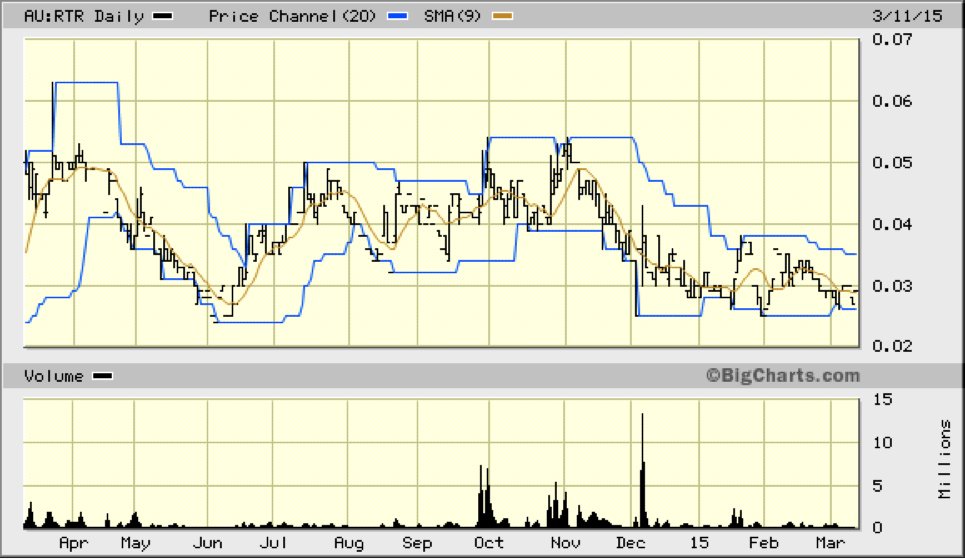 |
| Status: Advanced Explorer | |
| Size: Small Cap | |
| Commodity Exposure: Nickel | |
| Share Price: $0.19 | |
| 12-month Range: $0.14 – $0.43 | |
| Shares: 144m, Options: 15m | |
| Top 20: 50% | |
| Net Cash: $7m | |
| Market Value: $27m |
| Key Parameters | Rating (✓out of 5) | Quarterly Statistics |
| Management Quality | ✓✓✓✓✓ | Q4 2014 Exploration Spend: $0.488m |
| Financial Security | ✓✓✓✓ | Q4 2014 Administration Spend: $0.324m |
| Project Quality | ✓✓✓✓✓ | Exploration Spend 60%, Admin Spend 40% |
| Exploration / Resource Potential | ✓✓✓✓✓ | Q1 2015 Forecast Exploration Spend: $0.75m |
| Project Risk | ✓✓✓✓✓ | Q1 2015 Forecast Admin. Spend: $0.5m |
We introduced Matsa Resources to our Portfolio during September 2013, after a lengthy period following the stock via our Watch-List. The rationale for covering the story was two-fold: firstly, I have a very high level of regard for the company’s Managing Director Paul Poli; and secondly the company’s flagship Symons Hill Project is strategically situated just a short distance along strike from Sirius Resources’ (ASX: SIR) outstanding and ground-breaking Nova and Bollinger nickel discoveries in Western Australia.
Matsa Resources is actually a diverse exploration play, with interests in eight individual exploration plays that are at varying levels of advancement, comprising nickel, gold and copper. The overwhelming focus however, in terms of near-term market excitement and potential share price impact, is its Symons Hill Project and its Killaloe Joint Venture Project, both of which are targeting sulphide nickel discoveries within the hugely prospective and geographically vast Fraser Range province of Western Australia.
Matsa maintains strong exploration momentum on two fronts. Firstly, it has generated exciting EM survey results ahead of follow-up drilling at its Symons Hill project, where the combined strike length of anomalous bedrock Ni values exceeds 10km. The current program of high-powered EM at Symons Hill is hugely significant and is therefore likely to re-establish strong market interest into early 2015. Matsa has also generated encouraging drilling and down-hole EM results from its Killaloe joint venture project.
Recent Activity
High-powered Deep EM at Symons Hill
Back in October 2014 we reported that Matsa had executed a contract for a broad-scale, innovative ground Electro Magnetic (EM) survey at Symons Hill. Unfortunately, heavy rain and thunderstorm activity in the area during November delayed the commencement of survey activities until early December.
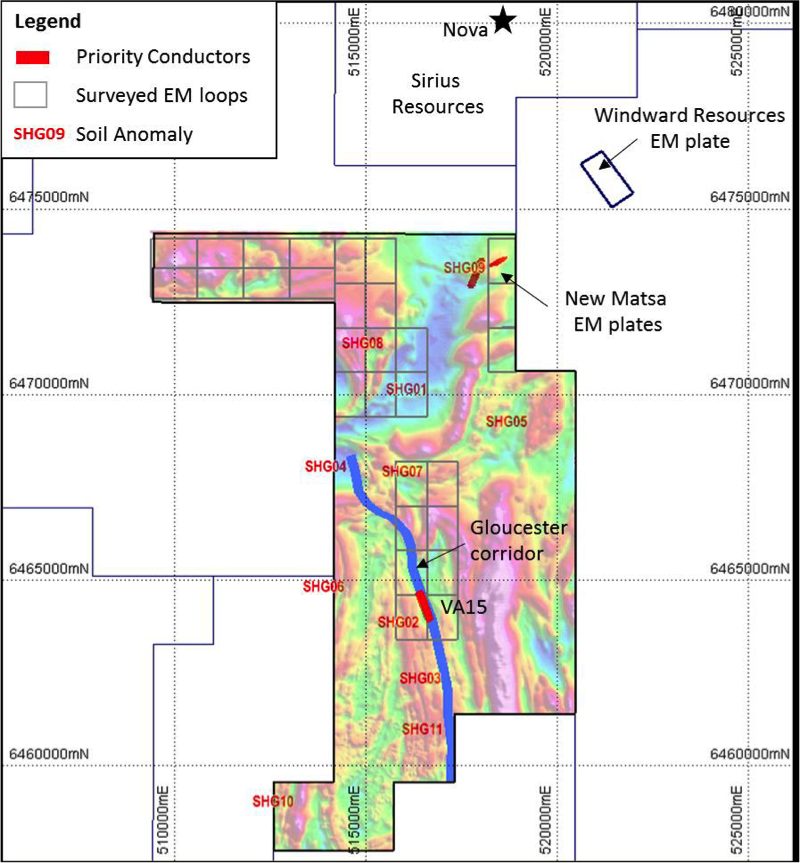
The EM technique is specifically designed to explore for highly-conductive Nova-Bollinger-style bedrock conductors to a depth of more than 700 metres.
The survey has been designed to test three successive, prioritised areas with the highest priority assigned to favourable structural/stratigraphic locations based on interpretation of gravity, aeromagnetic, geochemical and drilling data.
Results have so far been received for 29 out of 97 planned survey loops.
Technical Significance
Two high-priority conductivity responses (C42_1 and C47_1) have been interpreted from recent High Power Fixed Loop EM (HPFLEM) survey data within the northeastern corner of the Symons Hill project, just 6.5km from Sirius Resources’ (ASX: SIR) Nova-Bollinger Ni-Cu sulphide mine and 3.5km from Windward Resources’ (ASX: WIN) recently announced Western Margin conductor target.
The C42_1 target is interpreted to be located at a depth of ~200 metres – 300 metres below surface and to extend over an area of ~500 metres x 500 metres with conductance levels in the range of ~1500 – 2000 Siemens. The source is interpreted to strike ~NE-SW, which closely follows local aeromagnetic/magnetic trends. Modelling of data acquired to date currently indicates a steep dip/plunge to the NW for this conductor.
The C47_1 target is defined as a bedrock conductor although geometry, depth, and conductance levels are not yet able to be defined and final data from Loop 47 is required to define this target in sufficient drilling for drill-testing. Both the C42_1 and C47_1 targets are clearly identified in the graphic below. A follow-up diamond drilling program is being planned by Matsa.
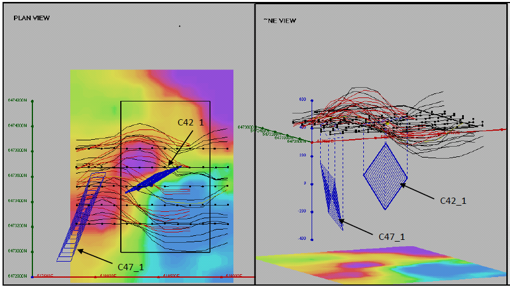
Matsa’s geophysical consultant, Russell Mortimer of Southern Geoscience Consultants, recently made the following comments: "Recent high powered MLTEM/FLTEM style surveying in the Fraser Range has extended the detection/definition depth of highly conductive "Nova" style bedrock conductors well beyond 500m as recently described/successfully drill tested by Sheffield Resources and Sirius Resources within adjacent tenure. After extensive multi-client experience and assessment efforts within the region, the best available technologies/methods have been contracted for this systematic tenement wide programme. This programme will also incorporate a research and development aspect with involvement from the CSIRO with regard to new EM sensor developments and transmitter technologies."
It is noteworthy that a recent EM survey by Sirius Resources using similar technology, defined 16 conductors to a depth of ~700m (SIR ASX announcement on 25 August 2014). Matsa therefore remains committed to exploring for massive Ni-Cu sulphides of the Nova-Bollinger style given the presence of highly prospective mafic/ultramafic intrusive rock types throughout the majority of the Symons Hill tenement.
The EM survey at Symons Hill is expected to take approximately five months to complete from commencement of ground activities.
Symons Hill and Killaloe Project Overview
Symons Hill covers a 96 sq km area and is located within just 2km of Sirius Resources’ tenement package and just 6km from the Nova discovery hole (4 metres 3.8% Ni and 1.42% Cu). Meanwhile at Fraser Range North, the project area comprises 353 sq km and is prospective for gold and base metals, just 20km northwest of the Nova discovery. The tenements lie in a similar geological setting as the Tropicana and Beachcomber deposits of Anglo Gold Ashanti/Independence Group.
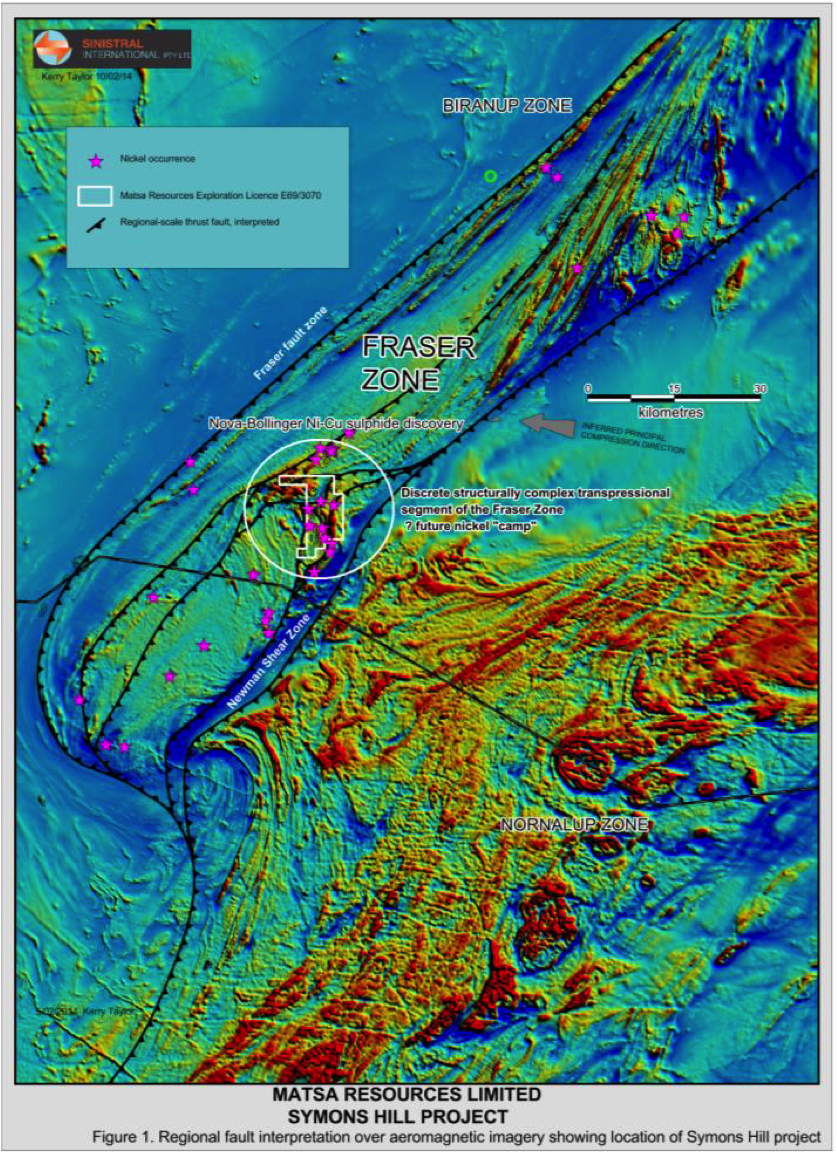
Killaloe Project
The Killaloe project comprises a joint venture between Matsa (80%) and Cullen Resources (20%), with exploration under the joint venture managed by Matsa. Nickel sulphide exploration has been focused on two belts of ultramafic rocks – the Western Ultramafic Belt (WUB) and the Eastern Ultramafic Belt (EUB). Documented past exploration for nickel over the Killaloe project commenced during the 1960’s and 1970’s by companies including Anaconda, Union Oil and Western Mining.
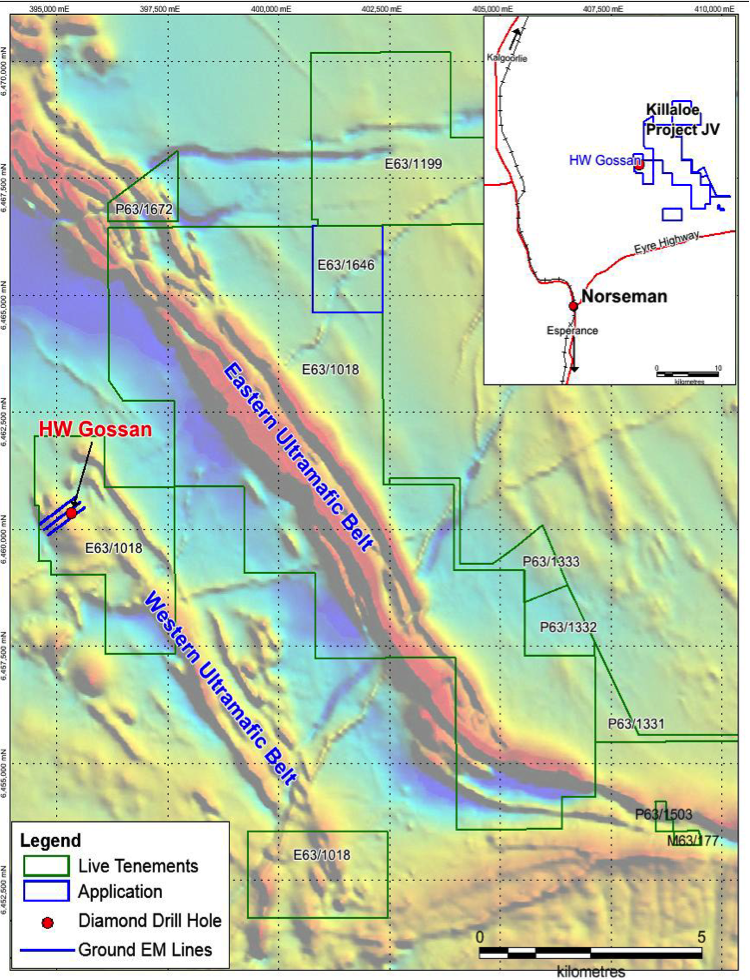
More recent nickel exploration during the early 2000’s was carried out by Cullen Resources via joint ventures with Sipa Resources (ASX: SRI) and Australian Nickel. Results from this work have been compiled into a comprehensive database comprising aeromagnetic/radiometric surveys, geological mapping, sampling, ground electromagnetic surveys and drilling. Reports based on this work point to similarities between rock units making up the WUB and EUB at Killaloe with the mafic/ultramafic sequence containing the Widgiemooltha and Kambalda nickel deposits, 60km and 100km respectively to the NW.
Drilling in the WUB by Sipa during 2004 achieved a sulphide nickel intercept in an RC drill-hole of 3 metres @ 0.49% Ni and 0.15% Cu at the Hanging Wall Gossan (HWG) prospect. More recently during July 2014, Ni sulphides were discovered by Sirius Resources at the Taipan prospect, which is located just 9km northwest of the Killaloe project in ultramafic komatiite lavas – which appear to be an extension of the Eastern Ultramafic Belt at Killaloe.
The Matsa-Cullen joint venture has completed six diamond drill-holes at Killaloe, comprising holes 14KLDH01 – 14KLDH06. Three of the five diamond drill-holes completed at the Hanging Wall Gossan (HWG) prospect prior to the December 2014 quarter, intersected disseminated nickel sulphide mineralisation in cumulate textured komatiite lavas.
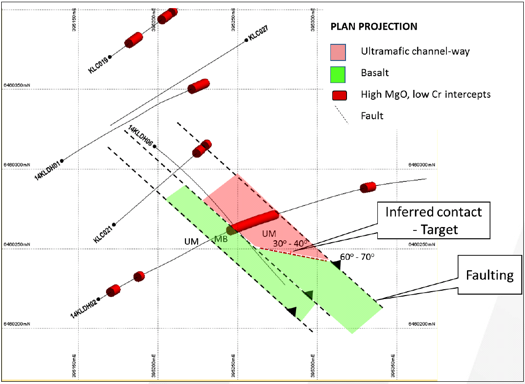
These very encouraging results are interpreted to confirm a location within or immediately adjacent to komatiite lava channels which are a primary control (particularly the basal contact) in the formation of massive Kambalda-style Ni sulphide mineralisation. Drilling has also confirmed that the komatiite sequence has been heavily disrupted by post-mineralisation faults.
Petrography carried out on semi-massive sulphides intersected in diamond hole 14KLDH01 (93.15m – 93.35m) confirmed the presence of the Ni sulphide violarite together with pyrite marcasite, and chalcopyrite. This assemblage was described at the time by the company’s petrographic consultant Roger Townend as being ”typical of partly oxidised WA komatiite ores from above 120m vertical depth”. This confirmation of classic Kambalda-type sulphide mineralogy has enhanced the prospectivity of the HWG prospect.
The most recent diamond drill-hole, 14KLDH06, was drilled during the December 2014 quarter and was designed to test the interpreted position of a basal contact in channel facies komatiite lavas, which is potentially an ore-bearing and focusing structure and considered to be the most prospective location for Kambalda-style nickel mineralisation.
The orientation of the hole was based on an analysis of bedding and fault directions in oriented diamond drill-core from holes 14KLDH01 – 14KLDH05, along with surface geological mapping. The analysis concluded that lithological contacts at HWG dip moderately towards the north and have been disrupted and offset by late-stage northwest-trending faults.
A total of 43 metres of elevated nickel values (>0.2%Ni and up to 0.58% Ni) is made up of several zones of disseminated nickel sulphides between 7m and 164m down-hole. Nickel mineralisation was observed in the drill-hole as finely disseminated violarite/pentlandite in association with pyrrhotite and chalcopyrite. The best assay result was 0.20m @ 0.58% Ni, 0.37% Cu and 0.07% Co from 111.3m – 111.5m depth. This intercept coincides with a narrow massive sulphide vein in komatiite.
14KLDH06 did not intersect the interpreted basal contact target zone because of drill-hole deviation due to faulting above the target. As a consequence, the predicted massive sulphide target at the base of the channel sequence remains untested.
Hole 14KLDH02 provided new assay results due to re-entry and extension of the original hole from 230m to a final depth of 396m in order to test a target defined by down-hole EM (DHEM) surveys. Two narrow zones of disseminated nickel sulphide mineralisation were intersected as follows: 0.25m @ 0.49% Ni, 0.09% Cu & 0.02% Co between 230.75m – 231m and 0.30m @ 0.54% Ni, 0.36% Cu & 0.04% Co between 232.9m – 233.2m .
The presence in these intersections of elevated copper values, a high Ni/Cu ratio and high MgO/Cr ratio, all provide strong support that they are located within a mineralised lava channel pathway.
Summary
Results from Symons Hill and Killaloe drilling are enormously encouraging, but patience is required. Investors unfortunately seem to demand Sirius-like drill-holes in almost every instance, which is obviously impossible. Matsa is undertaking intensive, deep EM surveys in order to identify the largest and most intense targets for follow-up drilling. This is a painstaking process, but obviously well worth the effort. We therefore keenly await the results of ongoing high-powered EM at Symons Hill as a precursor to deep drilling, along with follow-up drilling at Killaloe in the northern portion of the HWG target. We recommend Matsa Resources as a Speculative Buy.







